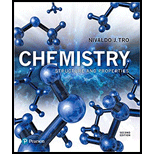
Solutions Manual For Chemistry: Structure And Properties
2nd Edition
ISBN: 9780134460697
Author: Tro
Publisher: PEARSON
expand_more
expand_more
format_list_bulleted
Question
Chapter 20, Problem 100E
Interpretation Introduction
To determine:
a) The initial radiation exposure of the animal
b) The dose of radiation to the animal in the first 4.0 hours following the ingestion of the radio-active material.
Expert Solution & Answer
Want to see the full answer?
Check out a sample textbook solution
Students have asked these similar questions
Topic: Photochemistry and Photophysics of Supramolecules
Two cations that exchange an electron in an interface, the exchange density is worth 1.39 mA/cm2 and the current density is worth 15 mA/cm2 at 25°C. If the overvoltage is 0.14 V, calculate the reaction rate and symmetry factor. Data: R = 8,314 J mol-1 k-1: F = 96500 C
With the help of the Tafel line, it is estimated that the interchange density of the VO2+/VO2+ system on the carbon paper has a value of 3 mA cm-2. Calculate a) the current density if the voltage has a value of 1.6 mV and the temperature is 25°C. b) the beta value of the anódico process if the Tafel pendulum is 0.6 V at 25°C. Data: R = 8.314 JK-1mol-1, y F = 96485 C mol-1.
Chapter 20 Solutions
Solutions Manual For Chemistry: Structure And Properties
Ch. 20 - Prob. 1ECh. 20 - Prob. 2ECh. 20 - Prob. 3ECh. 20 - Prob. 4ECh. 20 - Prob. 5ECh. 20 - Prob. 6ECh. 20 - Prob. 7ECh. 20 - Prob. 8ECh. 20 - Prob. 9ECh. 20 - Prob. 10E
Ch. 20 - Prob. 11ECh. 20 - Prob. 12ECh. 20 - Prob. 13ECh. 20 - Prob. 14ECh. 20 - Prob. 15ECh. 20 - Prob. 16ECh. 20 - Prob. 17ECh. 20 - Prob. 18ECh. 20 - Prob. 19ECh. 20 - Prob. 20ECh. 20 - Prob. 21ECh. 20 - Prob. 22ECh. 20 - Prob. 23ECh. 20 - Prob. 24ECh. 20 - Prob. 25ECh. 20 - Prob. 26ECh. 20 - Prob. 27ECh. 20 - Prob. 28ECh. 20 - Prob. 29ECh. 20 - Prob. 30ECh. 20 - Prob. 31ECh. 20 - Prob. 32ECh. 20 - Prob. 33ECh. 20 - Prob. 34ECh. 20 - Prob. 35ECh. 20 - Prob. 36ECh. 20 - Prob. 37ECh. 20 - Prob. 38ECh. 20 - Prob. 39ECh. 20 - Prob. 40ECh. 20 - Prob. 41ECh. 20 - Prob. 42ECh. 20 - Prob. 43ECh. 20 - Prob. 44ECh. 20 - Prob. 45ECh. 20 - Prob. 46ECh. 20 - Prob. 47ECh. 20 - Prob. 48ECh. 20 - Prob. 49ECh. 20 - Prob. 50ECh. 20 - Prob. 51ECh. 20 - Prob. 52ECh. 20 - Prob. 53ECh. 20 - Prob. 54ECh. 20 - Prob. 55ECh. 20 - Prob. 56ECh. 20 - Prob. 57ECh. 20 - Prob. 58ECh. 20 - Prob. 59ECh. 20 - Prob. 60ECh. 20 - Prob. 61ECh. 20 - Prob. 62ECh. 20 - Prob. 63ECh. 20 - Prob. 64ECh. 20 - Prob. 65ECh. 20 - Prob. 66ECh. 20 - Prob. 67ECh. 20 - Prob. 68ECh. 20 - Prob. 69ECh. 20 - Prob. 70ECh. 20 - Prob. 71ECh. 20 - Prob. 72ECh. 20 - Prob. 73ECh. 20 - Prob. 74ECh. 20 - Prob. 75ECh. 20 - Prob. 76ECh. 20 - Prob. 77ECh. 20 - Prob. 78ECh. 20 - Prob. 79ECh. 20 - Prob. 80ECh. 20 - Prob. 81ECh. 20 - Prob. 82ECh. 20 - Prob. 83ECh. 20 - Prob. 84ECh. 20 - Prob. 85ECh. 20 - Prob. 86ECh. 20 - Prob. 87ECh. 20 - Prob. 88ECh. 20 - Prob. 89ECh. 20 - Prob. 90ECh. 20 - Prob. 91ECh. 20 - Prob. 92ECh. 20 - Prob. 93ECh. 20 - Prob. 94ECh. 20 - Prob. 95ECh. 20 - Prob. 96ECh. 20 - Prob. 97ECh. 20 - Prob. 98ECh. 20 - Prob. 99ECh. 20 - Prob. 100ECh. 20 - Prob. 101ECh. 20 - Prob. 102ECh. 20 - Prob. 103ECh. 20 - Prob. 104ECh. 20 - Prob. 105ECh. 20 - Prob. 106ECh. 20 - Prob. 107ECh. 20 - Prob. 108ECh. 20 - Prob. 109ECh. 20 - Prob. 110ECh. 20 - Prob. 111ECh. 20 - Prob. 112ECh. 20 - Prob. 113ECh. 20 - Prob. 114ECh. 20 - Prob. 115ECh. 20 - Prob. 1SAQCh. 20 - Prob. 2SAQCh. 20 - Prob. 3SAQCh. 20 - Prob. 4SAQCh. 20 - Prob. 5SAQCh. 20 - Prob. 6SAQCh. 20 - Prob. 7SAQCh. 20 - Prob. 8SAQCh. 20 - Prob. 9SAQCh. 20 - Prob. 10SAQ
Knowledge Booster
Similar questions
- Hi can you please help me solve this problem? thank youarrow_forwardAn electrode process takes place at a metal-solution interface. Indicate the current condition that must be met for Faradaic rectification to occur.arrow_forwardAt a metal-solution interface, an electron is exchanged, and the symmetry factor beta < 0.5 is found in the Butler-Volmer equation. What does this indicate?arrow_forward
arrow_back_ios
SEE MORE QUESTIONS
arrow_forward_ios
Recommended textbooks for you
 Chemistry by OpenStax (2015-05-04)ChemistryISBN:9781938168390Author:Klaus Theopold, Richard H Langley, Paul Flowers, William R. Robinson, Mark BlaserPublisher:OpenStax
Chemistry by OpenStax (2015-05-04)ChemistryISBN:9781938168390Author:Klaus Theopold, Richard H Langley, Paul Flowers, William R. Robinson, Mark BlaserPublisher:OpenStax Chemistry for Engineering StudentsChemistryISBN:9781337398909Author:Lawrence S. Brown, Tom HolmePublisher:Cengage Learning
Chemistry for Engineering StudentsChemistryISBN:9781337398909Author:Lawrence S. Brown, Tom HolmePublisher:Cengage Learning Chemistry: The Molecular ScienceChemistryISBN:9781285199047Author:John W. Moore, Conrad L. StanitskiPublisher:Cengage Learning
Chemistry: The Molecular ScienceChemistryISBN:9781285199047Author:John W. Moore, Conrad L. StanitskiPublisher:Cengage Learning Chemistry for Today: General, Organic, and Bioche...ChemistryISBN:9781305960060Author:Spencer L. Seager, Michael R. Slabaugh, Maren S. HansenPublisher:Cengage Learning
Chemistry for Today: General, Organic, and Bioche...ChemistryISBN:9781305960060Author:Spencer L. Seager, Michael R. Slabaugh, Maren S. HansenPublisher:Cengage Learning ChemistryChemistryISBN:9781305957404Author:Steven S. Zumdahl, Susan A. Zumdahl, Donald J. DeCostePublisher:Cengage Learning
ChemistryChemistryISBN:9781305957404Author:Steven S. Zumdahl, Susan A. Zumdahl, Donald J. DeCostePublisher:Cengage Learning


Chemistry by OpenStax (2015-05-04)
Chemistry
ISBN:9781938168390
Author:Klaus Theopold, Richard H Langley, Paul Flowers, William R. Robinson, Mark Blaser
Publisher:OpenStax

Chemistry for Engineering Students
Chemistry
ISBN:9781337398909
Author:Lawrence S. Brown, Tom Holme
Publisher:Cengage Learning

Chemistry: The Molecular Science
Chemistry
ISBN:9781285199047
Author:John W. Moore, Conrad L. Stanitski
Publisher:Cengage Learning

Chemistry for Today: General, Organic, and Bioche...
Chemistry
ISBN:9781305960060
Author:Spencer L. Seager, Michael R. Slabaugh, Maren S. Hansen
Publisher:Cengage Learning

Chemistry
Chemistry
ISBN:9781305957404
Author:Steven S. Zumdahl, Susan A. Zumdahl, Donald J. DeCoste
Publisher:Cengage Learning